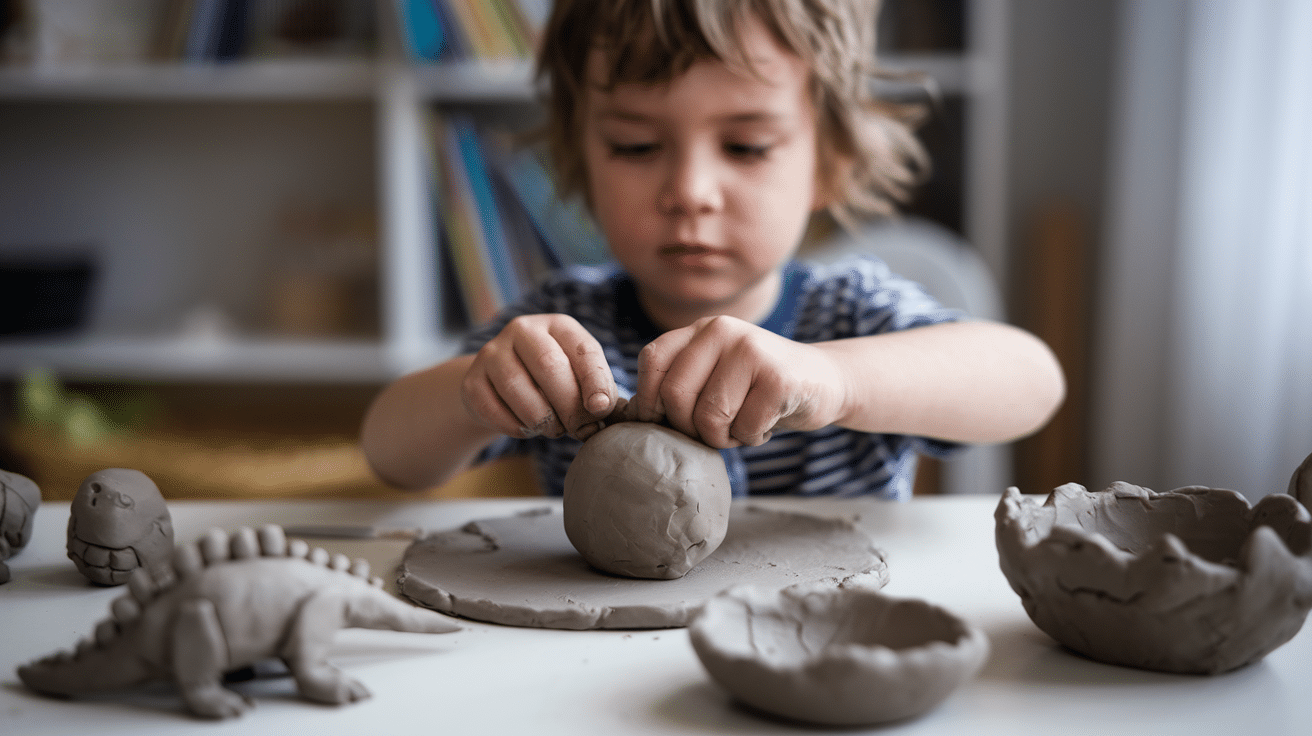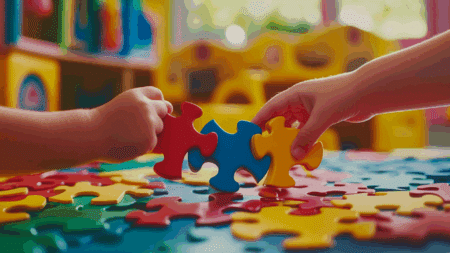Looking for fresh ways to keep kids busy that don’t involve screens?
When little ones get bored, finding good activities becomes a daily challenge for parents and teachers alike. Kids need hands-on play to learn and grow, but coming up with new ideas can feel like a full-time job.
Good news! Hands-on activities offer the perfect mix of fun and learning. They help children develop key skills while they’re having too much fun to notice they’re learning.
This guide shares practical, tested activities for kids of all ages – both at home and school. You’ll find simple ideas that build skills, pique interest, and create moments that matter. Plus, you’ll get helpful tips to make these activities work for your family!
Why Are Hands-On Activities Important for Kids’ Development?

Hands-on activities play a crucial role in how children learn and grow in their early years.
1. Physical skills grow through touch and movement: When kids use their hands to build with blocks, draw with crayons, or mold clay, they develop fine motor skills. These activities help their small muscles get stronger and work better together.
2. Brain connections form during play: Hands-on activities create neural pathways in a child’s brain. When they sort shapes, count objects, or mix colors, they learn about patterns, numbers, and cause-effect.
3. Problem-solving happens naturally: When a tower of blocks falls or a craft doesn’t work as planned, kids must think of new ways to fix it. This teaches them to try different approaches and not give up when things get hard.
4. Social skills build through group activities: Working with others on projects teaches kids to share, take turns, and communicate. They learn how to express ideas, listen to others, and work as a team.
5. Confidence comes from making things: Finishing a project gives kids a sense of pride and boosts their self-esteem. They see what they can create with their own hands and feel good about their abilities.
These simple, hands-on moments add up to big gains in how children develop and learn about their world.
At Home Educational Riot: Hands-On Activities for Kids

Create a DIY volcano and watch it erupt with baking soda and vinegar.
Make your own slime using household ingredients.
Build a solar oven with a pizza box to cook s’mores.
Scout magnetism with a DIY paperclip magnet experiment.
Make a bird feeder using pine cones, peanut butter, and bird seeds.
Grow crystals using a simple salt or sugar solution.
Create a rainbow in a jar with layers of colored liquids.
Learn about density by layering different liquids in a jar.
Build a cardboard bridge and test its strength with toys.
Create a DIY weather vane to track wind direction.
Set up a mini garden using a recycled bottle as a planter.
Make a kaleidoscope using mirrors, beads, and a tube.
Create a DIY sundial to learn how time works.
Build a homemade compass with a needle, magnet, and cork.
Make a DIY water filter with sand, gravel, and cotton balls.
Create a simple circuit with a battery, light bulb, and wire.
Build a rocket using a straw and paper and launch it.
Make an ocean in a bottle using water, oil, and glitter.
Use baking soda and vinegar to demonstrate chemical reactions.
Create a rainbow using a glass of water and sunlight.
Make a homemade lava lamp with oil, water, and food coloring.
Learn about shadows by making shadow puppets with a flashlight.
Make a DIY balloon-powered car.
Create a sensory bin with rice, beans, and small toys.
Build a simple pulley system with string and spools.
Make an edible plant cell model with fruits and candy.
Create a magnetic slime to scout magnetism.
Scout air pressure with a DIY balloon rocket.
Learn about evaporation with a simple water cycle experiment.
Build a simple marble run with cardboard and marbles.
Make a paper airplane and test different designs for flight distance.
Create a salt dough map of your country or continent.
Experiment with color mixing using primary-colored paints.
Make a paper lantern for a cultural study project.
Create a model of the solar system using Styrofoam balls.
Build a wind-powered vehicle with a fan and paper.
Create a DIY light-up card using LED lights and copper tape.
Make a DIY periscope using mirrors and a cardboard tube.
Build a homemade weather station to measure temperature and wind.
Create a cardboard animal habitat to learn about ecosystems.
Build a cardboard house to scout architecture.
Make a DIY musical instrument from household items.
Create a seed bomb to learn about planting and conservation.
Learn about simple machines by building a seesaw with a block and board.
Build a pendulum with a string, weight, and a hanger.
Make a sensory bottle to scout colors, lights, and sounds.
Scout the concept of gravity with a simple drop test.
Create a homemade sundial and compare it with a digital clock.
Make a paper bridge and test how much weight it can hold.
Learn about the phases of the moon with Oreo cookies.
Build a marble maze to study engineering concepts.
Make a DIY windmill with paper, straws, and a pin.
Build a potato-powered clock to learn about energy.
Create a simple pendulum clock with a swinging string.
Scout sound waves by making a DIY kazoo.
Build a balloon-powered boat to study propulsion.
Create a floating egg experiment to learn about buoyancy.
Make a simple weather journal to track temperature and humidity.
Experiment with soil types by planting seeds in different soils.
Create a DIY color-changing volcano using colored baking soda.
Educational Hands-On Activities for Kids: Classroom Edition

Build a model of the solar system using Styrofoam balls.
Create a birdhouse using popsicle sticks and glue.
Make a homemade thermometer with a straw and colored water.
Create a DIY pinhole camera to scout photography.
Build a tower using marshmallows and spaghetti.
Make a DIY rainbow with a glass of water and a flashlight.
Create a seed starter kit using egg cartons and soil.
Make a simple circuit with copper tape and a battery to light up an LED.
Build a bridge out of straws and test its weight capacity.
Make a map of your school or home with cardboard.
Create a working model of the water cycle in a jar.
Build a balance scale with a ruler and string.
Make a paper mache globe to understand continents and oceans.
Learn about fractions with a pizza-cutting activity using paper plates.
Create a pencil holder out of recycled materials.
Make a simple barometer with a balloon and a jar to measure air pressure.
Create a homemade calendar with days, weeks, and months using craft supplies.
Build a mini greenhouse using clear plastic and cardboard to grow plants.
Make a lava lamp using oil, water, and food coloring.
Create an edible plant cell model using different candies and fruits.
Build a pyramid using sugar cubes to understand geometry.
Make a kite and fly it to learn about wind and aerodynamics.
Create a simple compass using a magnet and a needle.
Build a cardboard roller coaster for marbles to study physics.
Make a working model of the digestive system using household items.
Create a balloon-powered boat to learn about propulsion.
Build a sandcastle with different textures to learn about soil properties.
Make a solar oven with aluminum foil and a pizza box to cook s’mores.
Create a paper rocket and measure how far it can travel with air pressure.
Build a mini dam with clay and water to understand water flow.
Make a sensory bottle to learn about colors and movement.
Create a homemade periscope using mirrors and cardboard.
Build a robot using simple materials like paper, plastic, and straws.
Create a simple pulley system with string and spools.
Learn about chemical reactions by making a homemade volcano.
Create a paper flower garden to learn about plant biology.
Build a cardboard car and race it down a ramp to learn about motion.
Create a water filter using activated charcoal, sand, and gravel.
Make a paper lantern to study the cultures that use them.
Build a magnet maze to scout magnetic fields.
Make a simple clock using cardboard and a paper plate.
Create a DIY wind vane to measure wind direction.
Build a cardboard city and understand the importance of planning.
Create a weather journal to track and predict local weather patterns.
Make a rubber band-powered car to study potential and kinetic energy.
Build a catapult using popsicle sticks and test its range.
Create a DIY aquarium using a glass jar and small fish.
Learn about sound waves by making a simple string phone.
Create a nature journal to study plant and animal life outside.
Build a simple DNA model using colored pasta to represent nucleotides.
Make a simple periscope using two mirrors and cardboard.
Create an interactive map of your town or city.
Learn about forces by creating a simple roller coaster for marbles.
Make a sundial to track the movement of the sun.
Build a model of a house with various building materials.
Create a shadow box to study the concept of shadows.
Make a DIY microscope with a magnifying glass and paper.
Learn about buoyancy by testing different objects in water.
Create a homemade kaleidoscope with mirrors and a tube.
Build a simple water clock to understand time measurement.
Fun Hands-On Activities for Kids to Enjoy at Home

Create a DIY obstacle course using household furniture.
Make a stress ball using flour and balloons.
Design and paint a ceramic mug using special paint markers.
Create a nature scavenger hunt in your backyard.
Build a LEGO city with buildings, roads, and vehicles.
Make a DIY bird feeder using toilet paper rolls and peanut butter.
Set up a DIY bowling game using plastic bottles and a ball.
Create a paper plate mask and decorate it as an animal.
Build a blanket fort and decorate it with lights.
Make a rainbow wind chime using colorful beads and string.
Create a fun sensory bin with rice, beans, and hidden toys.
Paint a rock and hide it for others to find in a community rock hunt.
Make a homemade friendship bracelet with colorful threads.
Create a DIY ice cream cone using colored paper and cotton balls.
Build a paper airplane launcher and see whose airplane flies the furthest.
Design a t-shirt with fabric paints or tie-dye.
Create a paper cup telephone to learn about sound waves.
Make homemade bubbles using dish soap, water, and a straw.
Build a castle from cardboard boxes and decorate it.
Create a sensory board with buttons, zippers, and other textured materials.
Make a kite using paper, sticks, and string, and fly it outside.
Set up a DIY photo booth with props and take fun pictures.
Create a handprint family tree using paint.
Make a marble run with cardboard and tape.
Build a paper lantern and decorate it with your favorite colors.
Make a footprint art by dipping your feet in paint and walking on paper.
Create a DIY journal using recycled paper and a stapler.
Design a personalized bookmark using stickers and markers.
Make a DIY sock puppet and put on a puppet show.
Create a paper chain garland to decorate your room.
Set up a science experiment to grow crystals on a string.
Make a sensory jar with glitter, water, and glue.
Create a DIY weather station to track temperature and humidity.
Paint a picture using sponges and acrylic paint.
Build a robot out of cardboard, foil, and other recycled materials.
Create a sand art jar using colorful sand and glue.
Make a tic-tac-toe board with a piece of cardboard and bottle caps.
Create a spinning top using a pencil and a CD.
Build a shoebox theater and put on a puppet show.
Create a DIY bubble wand using a pipe cleaner and string.
Make a pinwheel using paper, a pencil, and a pin.
Build a treasure chest and hide small toys or treats inside.
Set up a toy car race track and see which car goes the fastest.
Create a DIY lava lamp using oil, water, and food coloring.
Make a balloon rocket and launch it across the room.
Create a custom board game and play with family or friends.
Build a mini zoo using plastic animals and cardboard enclosures.
Paint a rock to look like your favorite animal.
Make a dream catcher using string, beads, and a hoop.
Create a paper plate tambourine with coins and ribbon.
Build a cardboard car and race it on a homemade racetrack.
Create a DIY paper boat and see how long it floats in water.
Set up a DIY mini carnival with games like ring toss and bean bag throw.
Make a personalized photo frame using craft supplies.
Create a fun DIY memory game using matching pictures on cardboard squares.
Make a windmill using paper and straws to see how the wind spins it.
Build a sandcastle indoors with kinetic sand.
Design your own board game with dice and cards.
Make a paper flower bouquet using tissue paper and wire.
Create a DIY pencil holder with recycled materials.
Paint a picture with your fingers for a fun, hands-on art experience.
Set up a scavenger hunt using clues and hidden treasures around your home.
Create a DIY necklace or bracelet using pasta and paint.
Build a homemade parachute using a plastic bag and string.
Make a fun face painting activity with safe, washable face paints.
Create a fun maze with straws on a piece of paper.
Build a paper rocket and launch it with a straw.
Create a treasure map using paper, markers, and tea bags.
Fun Learning in School: Engaging Hands-On Activities for Kids

Create a DIY paper circuit with LED lights to scout basic electronics.
Build a 3D shape model using playdough to learn about geometry.
Make a paper rocket and launch it with a straw to learn about aerodynamics.
Design a colorful timeline of historical events using craft paper.
Set up a mini science lab to scout the properties of different liquids.
Build a solar-powered car using a small solar panel and motor.
Create a graph using colored paper to represent different data points.
Learn about symmetry by folding paper and cutting shapes to reveal symmetrical designs.
Build a working model of a clock with moving hands to learn about time.
Create a nature journal to document plants and animals you observe around school.
Make a volcano with baking soda and vinegar to understand chemical reactions.
Create a weather station with homemade instruments to measure temperature, humidity, and wind speed.
Build a simple bridge using popsicle sticks and test its strength with small weights.
Use straws to make a geometric shape model to scout angles and shapes.
Create a 3D map of your school or neighborhood with clay and other materials.
Make a homemade sundial to study the movement of the sun throughout the day.
Build a cardboard catapult and test how far different objects can be launched.
Set up a mini garden in the classroom to observe plant growth and learn about ecosystems.
Create an edible map using food items to learn about geography.
Build a spinning top with a button and a pencil to scout rotational motion.
Make a paper airplane launcher and compete to see whose plane flies the furthest.
Design and build a bird feeder using recycled materials to study animal habitats.
Create a model of the solar system using foam balls to represent planets.
Learn about sound waves by making a DIY string telephone with cups and string.
Make a simple water filter using sand, gravel, and cotton balls to scout filtration.
Build a parachute using a plastic bag and test it with different weights to learn about gravity.
Create a paper mache globe to study the Earth’s continents and oceans.
Set up a toy car race track to scout friction and motion.
Make a sand and water table to study the properties of different materials.
Design and make your own board game that teaches math or science concepts.
Create a mini ecosystem in a jar to observe the water cycle and plant growth.
Build a paper house and learn about architecture and structural integrity.
Design a personalized bookmark using colors and patterns to promote reading.
Create a 3D collage of animals and their habitats to learn about wildlife.
Build a marble run with cardboard tubes to study motion and gravity.
Create a simple pendulum with a string and a weight to scout the concept of motion.
Make a model of a plant cell using different colored candies to represent cell parts.
Create a working model of the human circulatory system using red and blue straws.
Set up a DIY photo booth and learn about photography and lighting.
Make a time capsule to scout history and predict the future.
Create a DIY microscope with a magnifying glass and a paper tube.
Design and make a paper lantern to study light and shadow.
Build a simple boat from a plastic bottle and test how much weight it can carry.
Make a balloon-powered car to scout the concepts of air pressure and propulsion.
Create a mini version of a famous landmark using clay and other craft materials.
Hands-On Activities: Organizing Tips for Parents & Teachers

Setting up and managing hands-on activities doesn’t need to cause stress or mess. With a few simple steps, parents and teachers can make these fun learning moments run more smoothly.
- Plan ahead with a weekly activity chart: Having a schedule helps you gather materials before you need them and gives kids something to look forward to each day. You can even let children help pick activities for the upcoming week.
- Create a dedicated space for messy play: Set aside a spot in your home or classroom where spills and messes are okay. Use plastic tablecloths, old sheets, or shower curtains to protect floors and tables during art or science projects.
- Use clear plastic bins for storing materials: Label each container with words and pictures so kids can find and put away items on their own. This teaches responsibility while keeping your space tidy.
- Prep materials in advance when possible: Cut papers, portion out paints, or separate building materials before activity time. This reduces wait time and keeps children engaged instead of distracted.
- Teach a consistent clean-up routine: Make tidying up part of every activity by playing a special clean-up song or setting a timer for a quick pick-up race. Children learn best when clean-up becomes a habit.
- Keep a “finished work” area: Designate a shelf, bulletin board, or drying rack where kids can place completed projects. This shows you value their work and prevents freshly-made items from getting damaged.
- Document activities with photos: Take quick pictures of children engaged in activities and their finished products. These images help you remember successful projects and can be shared with families or used in portfolios.
With these organizing strategies, hands-on activities become less about the prep work and cleanup and more about the valuable learning and fun that happens in between. Both you and the children will enjoy the experience much more.
Wrapping It Up
So what does this mean for you? These simple activities at home or school can make a huge difference in how children grow and learn. They’re not just fun ways to pass time – they’re building blocks for future success.
What next? Start small. Pick one activity from our list that matches your child’s interests. Set up a dedicated space with clear bins for materials. Remember to plan ahead and create a cleanup routine.
Want to share your experiences? Leave a comment below about your favorite hands-on activities or ask questions about getting started.
Your path to hands-on learning begins today!




